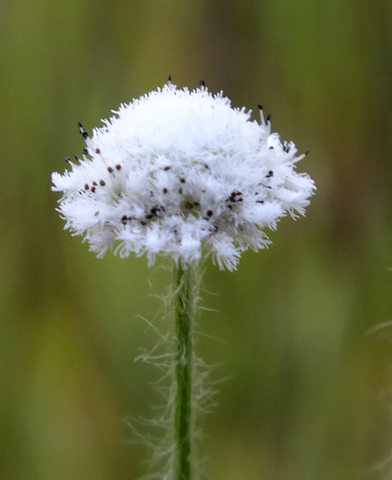Eriocaulon chantaranothaii

This species is similar to E. smitinandii as the scapes and the involucral bracts are hairy but it differs in having shorter and white hairs on the floral bracts; unequal male petals, one of which is exserted beyond the floral bracts; minute female sepal and glandular petals.
E. chantaranothaii is endemic to Thailand and restricted to Phitsanulok and Sakol Nakhon.
Annual herbs. Stem forming a basal disc. Leaves crowded into a basal rosette, linear, 1.5-2 cm long, 1 mm wide, hairy, apex acute. Scapes numerous, up to 23 cm long, hairy. Sheaths 2.5-3 cm long, hairy, apex acute. Capitula globose, 3-5 mm long, 4-6 mm in diameter, white. Receptacle convex, pilose. Involucral bracts broadly elliptic to oblanceolate, 1.5-2 mm long, brown, pilose, apex obtuse to acute. Floral bracts oblanceolate, 1.5 mm long, light brown, hairy in the upper part, apex acuminate. Male flowers: calyx spatheate, 3 lobed, acute, 1 mm long, brown, hairy in the upper part; petals unequal, hairy, acute, two small, the third about twice as long and exserted beyond the floral bract, subapical glands present; vestigial gynoecium present; anthers 6, black. Female flowers: sepals 1-3, narrowly linear, acute, 0.5-1 mm long, light brown, hairy in the upper part (deciduous); petals 3, unequal, elliptic or lanceolate, attenuate, acute, 1.5-2 mm long, brown, hairy in the upper part, subapical glands present; ovary 3-locular; seed 0.5 mm long, brown, glabrous
Flowering: October-Febuary
Common on sandy soils in open marshy places or on the borders of barren sandstone rocks. Altitude 120-500 m.

E. chantaranothaii had the male flower layers alternated with the female flower layers and the lowest layer was the male flowers, the average of the female-male flowers ratios per inflorescence was about 1 to 1 and the average pollen-ovule ratios was about 205 to 1.
